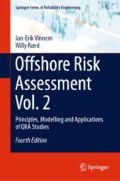Abstract
This chapter starts with a general discussion on the indicators of major hazard risk, followed by a discussion of the Risk Level project by PSA in Norway and the lessons learned from this project with respect to major hazard risk indicators. The final part discusses how major hazard risk indicators should be used by individual companies and installations, in order to control major hazard risk.
Access this chapter
Tax calculation will be finalised at checkout
Purchases are for personal use only
Notes
- 1.
2011 was the last year with available detailed data at the time of the manuscript preparation, 2017 is the last year with available overall data.
References
Safety Science (2009) Special issue, vol 47, no 4
Vinnem JE (2000) Risk monitoring for major hazards, SPE paper 61283. In: Presented at the SPE international conference on health, safety and environment in oil and gas exploration and production, Stavanger, 26–28 June 2000
Øien K, Sklet S (1999) Risk control during operation of offshore petroleum installations. In: Proceedings of ESREL=99, Munich, October, 1999. Balkema, pp 1297–1302
HSE (1995) Prevention of fire and explosion, and emergency response regulations. HMSO, London
Total E&P Norway (1998) Health, safety and environment. Annual report for 1997. Total E&P, Stavanger
Øien K, Sklet S, Nielsen L (1997) Risk level indicators for surveillance of changes in risk level. In: European safety and reliability conference 1997. Lisboa, Portugal
Baker J (2007) The report of the BP U.S. refineries independent safety review panel, ‘Baker report’, January 2007
Kjellén U (2009) The safety measurement problem revisited. Saf Sci 4(47):486–489
Ale B (2009) More thinking about process safety indicators. Saf Sci 47(4):470–471
Zwetsloot GIJM (2009) Prospects and limitations of process safety performance indicators. Saf Sci 47(4):495–497
Kvitrud A, Ersdal G, Leonardsen RL (2001) On the risk of structural failure on Norwegian offshore installations. In: Proceedings of ISOPE 2001, 11th international offshore and polar engineering conference, Stavanger, Norway
Kjellén U (2000) Prevention of accidents through experience feedback. Taylor & Francis, London and NY
Rockwell TH (1959) Safety performance measurement. J Ind Eng 10:12–16
Øien K (2001) A framework for the establishment of organizational risk indicators. Reliab Eng Syst Saf 74(2):147–167
Aven T (2003) Foundations of risk analysis. Wiley, New York
Vinnem JE et al (2006) Major hazard risk indicator for monitoring of trends in the Norwegian offshore petroleum sector. Reliab Eng Syst Saf 91(7):778–791
Aven T, Vinnem JE (2007) Risk management, with applications from the offshore oil and gas industry. Springer
Tharaldsen JE, Olsen E, Rundmo T (2008) A longitudinal study of safety climate on the Norwegian continental shelf. Saf Sci 46(3):427–439
Huber et al (2008) Learning from organisational incidents: resilience engineering for high-risk process environments. Process Saf Prog 28(1):90–95
PSA (2011) Guidelines to regulations relating yo material and information in the petroleum activities (the information duty regulations). Petroleum Safety Authority, 1 January 2011
Heide B (2009) Monitoring major hazard risk for industrial sectors. PhD thesis, University of Stavanger
PSA (2019) Trends in risk level on the Norwegian continental shelf, main report, (in Norwegian only, English summary report). Petroleum Safety Authority, Stavanger, 11 April 2019
Sklet S (2006) Safety barriers; definition, classification and performance. J Loss Prev Process Ind 19:494–506
Vinnem JE, Aven T, Sørum M, Øien K (2003) Structured approach to risk indicators for major hazards. In: Presented at the ESREL 2003 conference. Maastrict, 16–18 June 2003
Vinnem JE, Hestad JA, Kvaløy JT, Skogdalen JE (2010) Analysis of root causes of major hazard precursors in the offshore petroleum industry. Reliab Eng Syst Saf 95(11):1142–1153
HSE (1996) The offshore installations and wells (design and construction, etc.) regulations. HMSO, London
Vinnem JE, Pedersen JI, Rosenthal P (1996) Efficient risk management: use of computerized QRA model for safety improvements to an existing installation. In: 3rd international conference on health, safety and environment in oil and gas exploration and production, New Orleans, USA. SPE paper 35775
Vinnem JE (1997) On the sensitivity of offshore QRA studies. In: European safety and reliability conference, 1997, Lisboa, Portugal
NPD (1992) Regulations relating to explosion and fire protection of installations in the petroleum activities. Norwegian Petroleum Directorate, Stavanger, 1992, February
Syvertsen R (2006) Weight of importance for barriers in the offshore oil and gas industry. MSc thesis, University of Stavanger
Hale A (2009) Why safety performance indicators. Saf Sci 47(4):479–480
Vinnem JE (2010) Risk indicators for major hazards on offshore installations. Saf Sci 48(6):18p
Thomassen O, Sørum M (2002) Mapping and monitoring the safety level, SPE 73923. In: Presented at SPE international conference on health, safety and environment in oil and gas exploration and production, Kuala Lumpur, 20–22 March 2002
Vinnem JE et al (2007) Operational safety condition—concept development. In: Paper presented at ESREL 2007, Stavanger, 25–27 June 2007
Vinnem JE (2008) On causes and dependencies of errors in human and organizational barriers against major accidents. In: Presented at ESREL2008, Valencia, 22–25 September 2008
Høivik D, Moen BE, Mearns K, Haukelid K (2009) An explorative study of health, safety and environment culture in a Norwegian petroleum company. Saf Sci 47(7):992–1001
Austnes-Underhaug R et al (2011) Learning from incidents in Statoil (in Norwegian only). IRIS report 2011/156, 21 September 2011. Available from www.statoil.com
Rosness R, Guttormsen G, Steiro T, Tinmannsvik RK, Herrera IA (2004) Organisational accidents and resilient organisations: five perspectives. SINTEF report STF38 A 04403
Hansen HN, Rekdal O (2015) Barrier management for Goliat (in Norwegian only). ESRA Norway, 25 March 2015
Author information
Authors and Affiliations
Corresponding author
Rights and permissions
Copyright information
© 2020 Springer-Verlag London Ltd., part of Springer Nature
About this chapter
Cite this chapter
Vinnem, JE., Røed, W. (2020). Use of Risk Indicators for Major Hazard Risk. In: Offshore Risk Assessment Vol. 2. Springer Series in Reliability Engineering. Springer, London. https://doi.org/10.1007/978-1-4471-7448-6_23
Download citation
DOI: https://doi.org/10.1007/978-1-4471-7448-6_23
Published:
Publisher Name: Springer, London
Print ISBN: 978-1-4471-7447-9
Online ISBN: 978-1-4471-7448-6
eBook Packages: EngineeringEngineering (R0)

